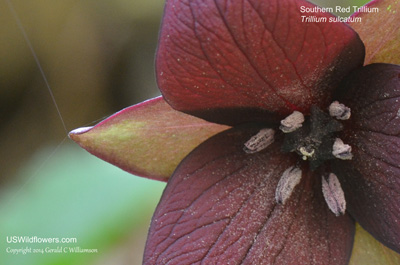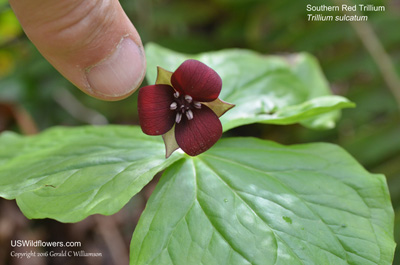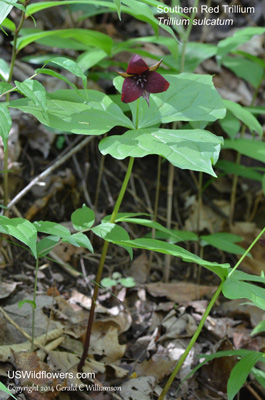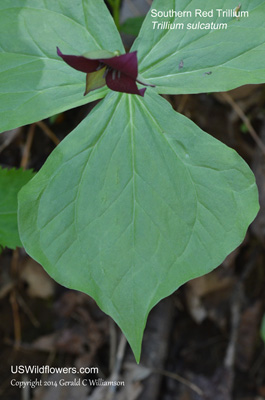Southern Red Trillium, Barksdale Trillium, Furrowed Wakerobin - Trillium sulcatum
|
Trillium sulcatum - Southern Red Trillium, Barksdale Trillium, Furrowed Wakerobin. Trillium was formerly classified in Liliaceae, but most authorities have placed it in Melanthiaceae, because unlike other Liliaceae, the petals and sepals of Trillium are distinctly different. A number of respected authorities now place Trillium in Trilliaceae.
Trillium sulcatum is one of the pedicellate Trilliums, frequently referred to as Wakerobins. It is found primarily on the Cumberland Plateau but also some other mountainous areas of seven southeastern states. It was originally thought to be included with Trillium erectum, but "Barksdale" (I believe this is botanist Dr. Alma Whiffen Barksdale) determined that it was at least a separate variety of Trillium. Building on that work, Georgia botanist T. S. Patrick, while a student at the University of Tennessee, formally described Trillium sulcatum as a separate species.
Found in:
AL, GA, KY, NC, TN, VA, WV
Leave comments on Trillium sulcatum at this link. | 
Distribution of Trillium sulcatum in the United States and Canada:

Blue=Native; Grey=Introduced
Map from USDA Plants Database:
USDA, NRCS. 2017. The PLANTS Database (http://plants.usda.gov, 08 May 2025). National Plant Data Team, Greensboro, NC 27401-4901 USA.
Search Our Database: Enter any portion of the Scientific, Common Name, or both.
Do a general Google search of the entire site:
#ad
 Follow USWildflowers on Twitter
#ad
| | Site: Cloudland Canyon State Park, Dade County, GA Date: 2014-April-16 | Photographer: Gerald C. Williamson
Nikon D7000
Tamron SP 90MM f/2.8 AF Macro | | Trillium sulcatum usually has deep maroon petals with maroon-streaked, green sepals, although sometimes the petals are creamy yellow, pink, white, or bi-colored. The anthers are usually purple to yellow, and the ovary is usually dark purple, sharing the dark ovary trait with T. simile and T. erectum var. album. The blossom is normally carried at a right angle to the pedicel. | | 
| | Site: Cloudland Canyon State Park, Dade County, GA Date: 2014-April-16 | Photographer: Gerald C Williamson
Nikon D7000 | | The sepals of Trillium sulcatum fold up along the edges (frequently more distinctly than in this specimen), providing both the species epithet sulcatum ("sulcat" is latin for "furrows") and the common name "Furrowed Wakerobin." Some describe the sepal as "boat shaped." | | Click on the photo for a larger image

| | Site: Piney River Trail, Rhea County, TN Date: 2016-April-08 | Photographer: Gerald C Williamson
Nikon D7000 | | The blossom of Trillium sulcatum can be pretty small; this is among the smallest I've seen. | | Click on the photo for a larger image

| | Site: Cloudland Canyon State Park, Dade County, GA Date: 2014-April-16 | Photographer: Gerald C Williamson
Nikon D7000 | | The Southern Red Trillium grows up to around 27 inches tall in rich woodlands, usually on moist north or east facing ledges, slopes, and streambanks. These were on a rocky, north-facing ledge along a stream in Cloudland Canyon State Park. | | Click on the photo for a larger image

| | Site: Cloudland Canyon State Park, Dade County, GA Date: 2014-April-16 | Photographer: Gerald C Williamson
Nikon D7000 | | The bracts (some experts call them "bracts", while some, along with most of us commoners, call them "leaves") are obovate (widest part closer to the tip than to the stem) and acuminate (sharply tapered tip.) They are up to around 8 inches long and across. | | Click on the photo for a larger image

|
References used for identification and information:
|
|
| |
| #ad
|
|







